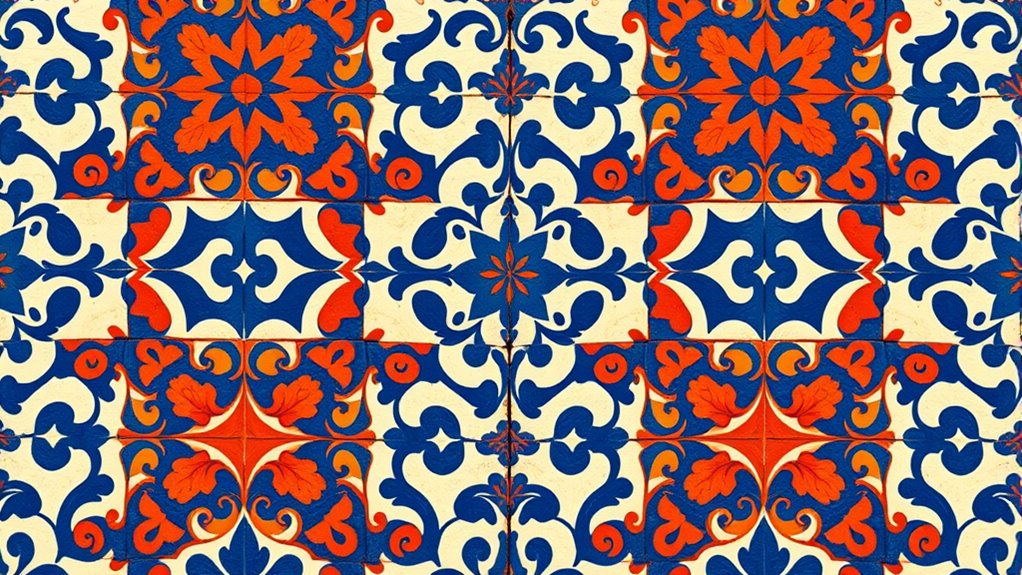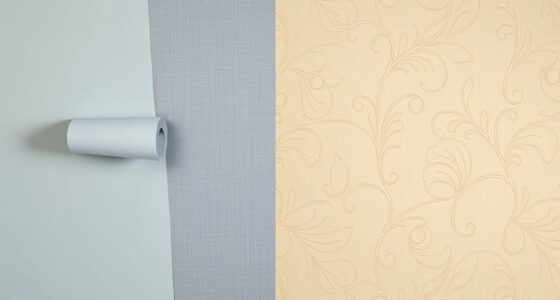To create hand-painted pattern walls with repeatable grids, start by preparing your wall with thorough cleaning and a smooth surface. Draw a precise grid using a level or chalk lines to divide the space into manageable sections. Use painter’s tape for clean edges and plan your color palette carefully. As you paint each section with steady strokes, focus on consistency and patience. Once finished, your pattern will be cohesive and vibrant—if you keep going, you’ll discover tips to perfect your design.
Key Takeaways
- Use a level, painter’s tape, or chalk lines to accurately sketch a grid that segments the wall for pattern repetition.
- Prepare walls thoroughly with cleaning, filling, and sanding to ensure smooth, crisp pattern lines.
- Apply primer to improve paint adhesion and prevent bleed-through, especially for bold or dark colors.
- Paint each grid section carefully with consistent strokes, alternating colors to create visual interest.
- Allow each section to dry completely before moving on to maintain pattern precision and avoid smudging.

Pattern walls can transform any space by adding visual interest and structure, especially when you incorporate grids. When you’re planning a hand-painted pattern wall, the first step is selecting the right color palette. Your choice of colors sets the tone and mood for the entire room, so pick hues that complement your existing decor. Bright and bold shades create energy, while softer tones evoke calm and serenity. Once you’ve settled on your colors, it’s essential to prepare your wall properly. Wall preparation is vital for a smooth, professional-looking finish. Start by cleaning the surface thoroughly to remove dust, dirt, and grease. If your wall has imperfections, fill cracks and holes with spackle or joint compound, then sand the surface until it’s even and free of bumps. A clean, smooth base ensures your paint adheres well and your pattern lines stay crisp.
Start by thoroughly cleaning and repairing your wall for a smooth, professional pattern finish.
Next, consider applying a primer if your wall has a bold or dark color underneath or if you’re painting a lighter color over a darker one. Primer improves paint adhesion and helps prevent bleed-through, especially important when working with multiple colors in a pattern. Once your wall is prepped and primed, you’re ready to sketch out your grid pattern. Using a level and painter’s tape or chalk lines, create a grid that divides the wall into manageable sections. This grid serves as a guide to keep your pattern consistent and evenly spaced, ensuring your repeat design looks professional. When you paint within these sections, you have better control, reducing mistakes and uneven lines.
To ensure your pattern aligns perfectly each time, accurate grid measurement is crucial for maintaining symmetry and consistency throughout your design. As you start painting your pattern, keep your brush strokes steady and consistent. For hand-painted designs, patience is key; take your time to fill in each section carefully, using the grid as your roadmap. Incorporating a deliberate color palette within each grid section can create a harmonious, balanced look. To add depth and interest, consider alternating colors or creating subtle variations within the pattern. Remember to let each section dry thoroughly before moving on to the next to prevent smudging or bleeding. If you make a mistake, don’t worry—lightly sanding and touching up is easier when you have a clean, prepped surface.
Ultimately, a well-executed hand-painted pattern wall with grids becomes a stunning focal point. It’s a personal touch that reflects your style and creativity. With thoughtful color choices and proper wall preparation, your pattern will look sharp and vibrant, transforming your space into something uniquely yours.
Frequently Asked Questions
What Types of Paint Are Best for Hand-Painted Pattern Walls?
For hand-painted pattern walls, you should choose acrylic or latex paints, as they’re durable and easy to work with. These paint types work well with various paint application techniques, allowing you to create crisp, detailed patterns. Use high-quality brushes or stencils for clean lines. Latex and acrylic paints dry quickly, giving you more control, and they’re easy to clean up after your project.
How Long Does It Take to Complete a Grid-Repeated Wall Pattern?
Completing a grid-repeated wall pattern is like planting a garden—you need patience and timing considerations. It usually takes between a few days to a week, depending on the pattern complexity and your pace. Proper project planning helps you allocate enough time for sketching, painting, and drying. Rushing can lead to mistakes, so set realistic deadlines to guarantee your design turns out perfect.
Can I Use Stencils to Assist With Grid Alignment?
Yes, you can definitely use stencil techniques to assist with grid alignment. To do this effectively, follow grid alignment tips like marking light pencil lines or tape to keep your stencils straight. This helps guarantee your pattern repeats seamlessly and maintains a professional look. Using stencils makes the process easier and more precise, especially if you’re new to hand-painting or working on complex designs.
What Are Common Mistakes to Avoid When Creating Grid-Based Patterns?
Creating grid-based patterns is like weaving a tapestry, so avoid common mistakes like alignment errors and inconsistent spacing. You want your lines straight and your patterns uniform, so double-check measurements often. Don’t rush or skip marking your grid carefully—these errors can cause uneven designs. Use a level or a ruler to keep everything aligned, and take your time to ensure each section fits perfectly.
How Do I Maintain and Clean Hand-Painted Patterned Walls?
To keep your hand-painted patterned walls looking great, regularly dust them with a soft cloth. For dirt or smudges, gently clean with a damp cloth and mild soap. When needed, do paint touch-ups to cover scratches or marks, ensuring you match the original colors and patterns. If wall repair is necessary, lightly sand the area first, then repaint to restore the pattern seamlessly and maintain the wall’s beauty.
Conclusion
By mastering the art of hand-painted pattern walls with grids, you can transform any space into a mesmerizing masterpiece. Don’t be afraid to experiment and let your creativity run wild—your walls will thank you for the stunning upgrade. With patience and precision, you’ll create a design so enthralling, it’ll outshine even the brightest stars. So go ahead, embrace the grid, and turn your walls into a breathtaking work of art that leaves everyone in awe.









